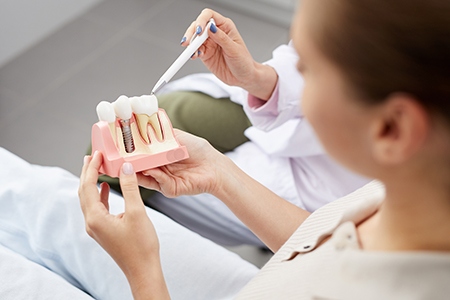
Missing teeth change more than the way your smile looks — they can alter how you eat, speak, and even how your face supports soft tissues. Modern dental implants are designed to restore tooth function by replacing both the visible tooth and the root beneath the gum. Because implants anchor directly into the jawbone, they recreate the stability and force transmission of a natural tooth, helping you enjoy a fuller diet and clearer speech again.
Implant dentistry has become the standard of care for many people who want a durable, natural-feeling solution for tooth replacement. At the office of Fay Hu General Dentistry, we focus on creating treatment plans that respect each patient’s health, goals, and comfort. Our approach balances proven surgical techniques with careful restorative design so the final result looks good and performs reliably over time.

Dental implants are titanium or titanium-alloy posts placed into the jaw where a tooth root once was. Over the following months, the implant becomes firmly integrated with bone through a process called osseointegration. This creates a stable foundation for a replacement tooth — whether a single crown, a bridge, or a full-arch prosthesis — that behaves much like the original tooth in daily function.
Because implants engage the bone, they help preserve the jaw structure that otherwise shrinks after tooth loss. That preservation keeps facial contours healthier and supports long-term oral function. For many patients, an implant-supported restoration can be indistinguishable from a natural tooth in terms of comfort, appearance, and ability to chew.
Implants are chosen for their predictability and the quality of life improvements they offer. Unlike removable appliances, implant-supported restorations reduce movement and eliminate many of the compromises that come with traditional dentures. Because implants act as independent anchors, they reduce the need to modify adjacent healthy teeth — an important consideration when preserving the remaining natural dentition.
Long-term studies show high success and patient satisfaction when implants are placed with proper planning and followed by good oral hygiene. Implant restorations allow patients to eat a wider variety of foods, speak with confidence, and maintain a more youthful facial profile by slowing the bone loss that follows tooth extraction.
While implant therapy requires a commitment to good home care and routine dental visits, the benefits in function, stability, and appearance make it a durable solution for many people facing tooth replacement.

Good implant outcomes begin with careful evaluation. During your consultation, we review your medical history, examine the mouth, and use imaging to assess bone volume and anatomy. That information helps us design a plan tailored to your needs — the number and location of implants, whether bone augmentation is required, and the timing of the restorative phase.
Not every case is identical, and contemporary implant dentistry offers multiple pathways to a successful outcome. When bone quantity or quality is limited, we can consider supplemental procedures to build a stable foundation. Our goal is a predictable treatment sequence that minimizes surprises and supports long-term health.
Placing implants is typically performed as a brief outpatient procedure using local anesthesia, and sedation options are available for patient comfort. The surgical visit focuses on accurate placement of the implant fixtures; after that, the site is allowed to heal while the implant integrates with the bone. Healing times vary, but during this phase we monitor progress and plan the final restorative steps.
When integration is complete, we design and attach the final crown, bridge, or denture so the restoration matches your bite, function, and aesthetic goals. Throughout treatment, our team emphasizes clear communication and step-by-step instructions for pre- and post-operative care to support a smooth recovery.
Some patients require augmentation to build a reliable implant site. Bone grafting can restore lost volume after infection or long-standing tooth loss, offering the structural support necessary for stable implant placement. Grafting techniques and materials have advanced substantially, allowing many patients who were once considered poor candidates to proceed with implant therapy.
Whether a minor graft at the time of extraction or a more extensive reconstruction, the decision to graft is based on clinical evaluation and discussion of expected outcomes. Properly performed augmentation increases the predictability and longevity of the implant-supported restoration.

Long-term success depends on routine maintenance. Daily plaque control, regular professional cleanings, and periodic checkups help prevent complications around implants. Our team provides specific hygiene guidance and follow-up scheduling so potential issues are detected early and managed with minimal disruption.
Implants are not immune to problems, but with informed care and regular monitoring they can remain a dependable part of your mouth for many years. Our focus is on building a restoration that fits your life and then supporting it through preventive care.
When tooth loss affects your comfort, function, or confidence, implant dentistry offers solutions that look natural and perform reliably. The office of Fay Hu General Dentistry combines careful planning, modern techniques, and patient-centered communication to help you choose the best path forward for your health and smile.
If you would like to learn more about implant dentistry or discuss whether implants are right for you, please contact us for more information. Our team is ready to answer your questions and guide you through the next steps.

If you've lost a tooth due to injury, decay, gum disease, or any other reason, we recommend dental implants to replace missing teeth. Dental implants come the closest to replicating the look, feel, and function of your natural teeth.
Dental implants are placed into the jawbone and mirror the same function as the root of a tooth. The procedure for dental implants is usually performed while a patient is sedated. Patients who undergo IV sedation must have an empty stomach and transportation home following the procedure. Most sedation patients will have little to no memory of the procedure occurring.
Generally, dental implants are made out of a biocompatible metal such as titanium. Biocompatible metals are also used for other common bone implants (such as shoulder, hip, and knee replacements). The visible portion of the implant is usually made out of porcelain and is custom-made to match your existing teeth.
Dental implants are designed to fuse to the bone, which makes them become permanent fixtures. Typically speaking, the success rate is nearly 100%. There are few cases in which the implant will not fuse as intended and must be removed. If this happens to occur, the procedure can be attempted again a few months later.
Dental implants are not usually covered by dental insurance, but may be covered under a patient's medical insurance. Our office and your insurance company can discuss coverage options with you based on your individual case and treatment plan.
It's easy... just take care of an implant as if it's a natural tooth! This involves regular brushing, flossing, and dental checkups. If you have any concerns about your implant, contact us immediately.
Dental implants are small, biocompatible posts surgically placed into the jawbone to replace missing tooth roots. Once an implant is positioned, the surrounding bone gradually fuses to the implant surface through a process called osseointegration, creating a stable foundation. This stability allows the implant to support crowns, bridges, or dentures that restore chewing function and appearance.
The implant itself is typically made from titanium or a titanium alloy because these materials integrate reliably with bone. After osseointegration, a restorative component called an abutment is attached and a custom crown or prosthesis is fabricated to match surrounding teeth. The result is a replacement that mimics the function and biomechanics of a natural tooth root and crown.
Dental implants provide superior stability because they are anchored in the jawbone, which helps restore normal chewing forces and prevents shifting of adjacent teeth. Implants also preserve bone by transmitting functional load to the underlying bone, reducing the bone loss that commonly follows tooth extraction. Because implants replace the root as well as the visible tooth, they support facial contours and help maintain a more natural appearance over time.
Unlike removable dentures, implant-supported restorations do not slip or require adhesives, so patients often experience improved comfort and confidence while speaking and eating. Implants do not decay like natural teeth, and in many cases they eliminate the need to alter healthy adjacent teeth as is sometimes necessary with conventional fixed bridges. With proper care, implants offer a long-term option for restoring both function and esthetics.
Single-tooth implants replace a missing tooth with an individual implant and crown, offering a conservative option that does not involve preparing neighboring teeth. Implant-supported fixed bridges use a small number of implants to support multiple replacement teeth, preserving adjacent natural teeth and providing long-term stability. Implant-retained crowns and bridges can be designed to be fixed or, in some cases, removable for cleaning and maintenance.
For patients missing an entire arch, full-arch solutions such as All-on-4 or All-on-6 use strategically placed implants to support a fixed prosthesis that looks and functions like natural teeth. Implant-retained dentures attach to implants to improve retention and comfort compared with conventional dentures while allowing easier cleaning. Your dentist will recommend the best restoration based on the number of missing teeth, bone volume, and functional needs.
Many adults who are missing one or more teeth are candidates for dental implants, but candidacy depends on a range of factors including overall health, oral hygiene, and the amount of available jawbone. Conditions such as uncontrolled diabetes, heavy tobacco use, or certain immune disorders can affect healing and integration, so those issues will be evaluated during consultation. Adequate bone volume is essential for implant stability, and if bone is insufficient, grafting can often prepare the site for successful implant placement.
During a consultation we will review your medical and dental history, perform a clinical exam, and use digital imaging to assess bone and anatomical structures. The office of Fay Hu General Dentistry uses modern diagnostic tools such as CBCT to plan implant placement precisely and to determine whether additional procedures are needed. Based on that information, the team will develop a tailored treatment plan to meet your functional and esthetic goals.
Implant treatment begins with thorough planning and imaging to determine optimal implant position, angulation, and prosthetic design. The surgical placement of the implant is usually performed on an outpatient basis and can range from a straightforward single-implant procedure to more involved cases that require grafting or multiple implants. In many cases a temporary crown or prosthesis can be provided while the site heals.
After placement the implant must integrate with the surrounding bone, a process that typically takes several months depending on the site and any additional procedures performed. Once osseointegration is confirmed, an abutment is attached and final restorations are fabricated to restore occlusion and esthetics. Follow-up visits ensure healing is proceeding well and the restorative components fit and function correctly.
Bone grafting is recommended when the jawbone lacks sufficient volume or density to support an implant, which can occur after tooth extraction, long-term tooth loss, or advanced periodontal disease. Without adequate bone, an implant may not achieve the stability required for long-term success, so grafting rebuilds volume and provides a stable foundation. Grafting materials can include the patient’s own bone, donor bone, or synthetic bone substitutes, depending on the clinical situation.
Some grafts are performed as a separate preparatory procedure and require a healing period before implant placement, while in other cases a graft can be placed at the same time as the implant. The timeline for healing varies with the type and size of the graft, as well as the individual’s biology. Your dentist will explain the recommended approach, expected healing timeline, and how grafting supports predictable implant outcomes.
Dental implants are supported by a large body of clinical research and have demonstrated high long-term success rates when placed and maintained properly. Common risks include infection at the surgical site, failure of osseointegration, or injury to nearby structures such as nerves or sinus cavities when anatomy is not adequately assessed. Health factors such as smoking, uncontrolled systemic disease, or poor oral hygiene can increase the risk of complications and affect implant longevity.
With careful case selection, modern surgical planning, and good postoperative care, many studies report success rates above 95 percent for routine implant cases. Long-term success also depends on patient maintenance, regular dental visits, and addressing parafunctional habits such as heavy clenching or grinding. Your dental team will review specific risks for your situation and the measures taken to minimize them.
Caring for dental implants is similar to caring for natural teeth and includes diligent daily oral hygiene such as brushing twice a day and cleaning between teeth with floss or interdental brushes. It is important to remove plaque and biofilm around the implant-abutment interface and adjacent teeth to reduce the risk of peri-implant inflammation. Patients with implants should avoid using tobacco products and follow any dietary or activity restrictions recommended during the healing period.
Routine professional care is essential, so schedule regular dental checkups and cleanings to monitor implant health and surrounding tissues. Your dental team may recommend specialized maintenance tools or techniques tailored to your prosthesis, such as removable prosthesis hygiene or use of a water flosser. Prompt attention to any signs of redness, swelling, mobility, or discomfort helps protect the long-term success of the restoration.
When planned and restored carefully, dental implants can achieve highly natural esthetics and a comfortable occlusion that closely mimic natural teeth. Modern restorative techniques, digital impressions, and chairside color matching allow custom crowns and prostheses to blend with adjacent teeth in shape, size, and shade. Because the implant supports a restoration rather than sitting on the gum like a removable denture, it often feels more like a natural tooth when biting and speaking.
Beyond appearance, implants help preserve the underlying bone and facial contours that support a natural smile over time. Many patients report improved confidence when implants restore function without the slipping or bulk associated with some removable options. Ongoing maintenance and occasional adjustments ensure the restoration continues to perform and look its best.
During your consultation ask about the clinician’s experience with implant treatment, the diagnostic tools used for planning, and the detailed sequence of procedures for your case. It is helpful to discuss imaging such as CBCT, options for sedation or anesthesia, and the expected timeline for grafting, healing, and final restorations. Clarify who will perform surgical and restorative steps and how communication between specialists will be managed if multiple providers are involved.
Also ask about long-term maintenance protocols, follow-up schedules, and what signs of trouble to watch for so you can respond promptly to any concerns. Discuss how implant restorations will be fabricated, including any digital workflows or in-office capabilities like chairside color matching and digital impressions. The team at Fay Hu General Dentistry can review these topics and provide a personalized plan based on your anatomy and goals.

We are dedicated to providing the highest quality of dental care to our patients.
Through excellence in dentistry and quality in relationships, we strive to positively impact your oral health, aesthetics, and self-esteem. From the front desk to the treatment room, our experienced team is here to support you with expert care and genuine compassion.